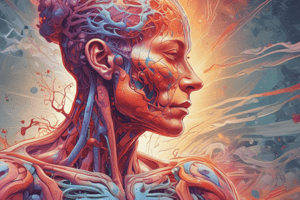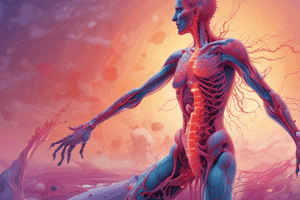Podcast
Questions and Answers
What is the primary physiological role of inflammation?
What is the primary physiological role of inflammation?
- To promote tissue destruction
- To suppress the immune response
- To enable survival during infection or injury (correct)
- To inhibit blood flow to injured tissues
Which of the following is NOT one of the four cardinal signs of inflammation identified by Cornelius Celsus?
Which of the following is NOT one of the four cardinal signs of inflammation identified by Cornelius Celsus?
- Rubor (redness)
- Dolor (pain)
- Erythema (redness) (correct)
- Calor (heat)
What event leads to the swelling associated with inflammation?
What event leads to the swelling associated with inflammation?
- Decreased cellular metabolism
- Release of vasoconstrictive mediators
- Constriction of blood vessels
- Extravasation of fluid and leukocytes influx (correct)
What mechanism is involved in the recruitment of phagocytes during inflammation?
What mechanism is involved in the recruitment of phagocytes during inflammation?
What is the term for the temporary decline in tissue function that occurs during inflammation?
What is the term for the temporary decline in tissue function that occurs during inflammation?
What characterizes septic shock?
What characterizes septic shock?
Which of the following is NOT a role of TNF-α, IL-1b, and IL-6 in response to infection?
Which of the following is NOT a role of TNF-α, IL-1b, and IL-6 in response to infection?
What is the mortality rate associated with septic shock?
What is the mortality rate associated with septic shock?
What mediates the anti-inflammatory response in the body?
What mediates the anti-inflammatory response in the body?
Which statement accurately explains the role of the HPA axis?
Which statement accurately explains the role of the HPA axis?
What physiological effect occurs due to the mass release of inflammatory mediators in septicemia?
What physiological effect occurs due to the mass release of inflammatory mediators in septicemia?
Which condition can be the result of uncontrolled systemic inflammation in sepsis?
Which condition can be the result of uncontrolled systemic inflammation in sepsis?
What is primarily stimulated by the production of TNF-α and other mediators during sepsis?
What is primarily stimulated by the production of TNF-α and other mediators during sepsis?
What typically initiates the resolution of acute inflammation?
What typically initiates the resolution of acute inflammation?
Which outcome is most likely when tissues can regenerate with little damage from acute inflammation?
Which outcome is most likely when tissues can regenerate with little damage from acute inflammation?
What is a hallmark of granulomatous inflammation?
What is a hallmark of granulomatous inflammation?
Which process is primarily responsible for scarring (fibrosis) following acute inflammation?
Which process is primarily responsible for scarring (fibrosis) following acute inflammation?
What might indicate the progression from acute to chronic inflammation?
What might indicate the progression from acute to chronic inflammation?
What physiological purpose does inflammation serve?
What physiological purpose does inflammation serve?
Which of the following is NOT a common physiological effect associated with acute inflammation?
Which of the following is NOT a common physiological effect associated with acute inflammation?
What is the role of Pattern Recognition Receptors in inflammation?
What is the role of Pattern Recognition Receptors in inflammation?
Which of the following inflammatory mediators is primarily associated with increased vascular permeability?
Which of the following inflammatory mediators is primarily associated with increased vascular permeability?
What is a likely consequence of chronic inflammation?
What is a likely consequence of chronic inflammation?
In response to which type of stimuli do mast cells and platelets release vasoactive amines?
In response to which type of stimuli do mast cells and platelets release vasoactive amines?
Which process primarily leads to the elimination of pathogens during the acute inflammatory response?
Which process primarily leads to the elimination of pathogens during the acute inflammatory response?
What condition can result from a shift in homeostatic set points due to inflammation?
What condition can result from a shift in homeostatic set points due to inflammation?
What characterizes the structure of a granuloma?
What characterizes the structure of a granuloma?
Chronic low-grade inflammation is commonly associated with which of the following conditions?
Chronic low-grade inflammation is commonly associated with which of the following conditions?
What is primarily altered by inflammatory mediators during the inflammatory response?
What is primarily altered by inflammatory mediators during the inflammatory response?
Which statement correctly describes systemic inflammation during the acute phase response?
Which statement correctly describes systemic inflammation during the acute phase response?
What feature distinguishes chronic inflammation from acute inflammation?
What feature distinguishes chronic inflammation from acute inflammation?
What is the main role of the leukocyte adhesion cascade during inflammation?
What is the main role of the leukocyte adhesion cascade during inflammation?
Which neutrophil function is directly affected by the mutation of the b2 subunit of integrins?
Which neutrophil function is directly affected by the mutation of the b2 subunit of integrins?
What type of cells can be found within granulomas in response to certain infections?
What type of cells can be found within granulomas in response to certain infections?
Study Notes
Inflammation
- Physiological Role: Inflammation is a vital immune response triggered by harmful stimuli like infection or tissue injury. It aids in survival during infection or injury and maintains tissue homeostasis.
- Cardinal Signs: Redness (rubor), Swelling (tumor), Heat (calor), Pain (dolor)
- Acute Inflammatory Response: Involves the delivery of blood components to the site of infection or injury.
- Stages of Acute Response:
- Recognition of infection/injury
- Release of soluble mediators
- Vasodilation, increased blood flow
- Vascular leakage, edema
- Extravasation of fluid and leukocytes (primarily PMNs)
- Phagocytosis, release of toxic compounds
- Elimination of infection, tissue repair, resolution
Different Types of Inflammation
- Triggers: Infection, Tissue Injury, Tissue stress and Malfunction
- Physiological Purpose: Host defense against infection, Tissue repair response, Adaptation to stress and restoration of homeostatic state
- Pathological Consequences: Autoimmunity, inflammatory tissue damage and sepsis, Fibrosis, metaplasia, Tumor growth, Diseases of homeostasis, Autoinflammatory diseases
Inflammation Sensors
- Pattern Recognition Receptors (PRRs):
- Toll-like Receptors (TLRs)
- Nod-like Receptors (NLRs)
- Rig-like Receptors (RLRs)
- C-type Lectin Receptors
Inflammation Mediators
- Influence: Vasculature functionality and leukocyte recruitment.
Inflammation Mediators (1)
- Vasoactive Amines: Histamine and serotonin produced by mast cells and platelets degranulation.
- TNF-α, IL-1b, IL-6: Stimulate hepatocytes to synthesize and secrete acute phase proteins
Sepsis- Septic Shock
- Sepsis: Organ dysfunction due to a dysregulated host response to infection.
- Septic Shock: Subset of sepsis with a drop in blood pressure unresponsive to vasopressors or fluid replacement, associated with poor outcomes.
- Causative Agent: Bacterial septicemia (Gram+/-)
- Mechanism: Systemic activation of TLRs on monocytes, massive release of inflammatory mediators, activation of coagulation and complement cascades, leading to uncontrolled systemic inflammation
- Consequences: Shock from loss of blood pressure, widespread coagulation (DIC), immunosuppression, immunoparalysis, multi-organ failure, death
Regulation of Inflammation
- Control Points: Inducers, Sensors, Mediators, Target tissues
- Major Anti-inflammatory Mediators: IL-10, TGF-β, glucocorticoids
Regulation of Inflammation (2)
- HPA axis: Hypothalamic-pituitary-adrenal axis controls production of corticosteroids, potent anti-inflammatory hormones.
Outcomes of Inflammation
- Chronic Inflammation: Granuloma, Tertiary lymphoid organs, Scarring, Fibrosis, Loss of function
- Acute Inflammation: Elimination of infection, Tissue repair, Resolution (Homeostasis)
Resolution of Inflammation
- Mechanisms: Switching from proinflammatory prostaglandins to anti-inflammatory lipoxins, transition from neutrophil to monocyte recruitment.
Phases of Acute Inflammation:
- Not specified in the text.
Possible Outcomes of Acute Inflammation
- Complete Resolution: Tissues capable of regeneration, minimal tissue damage
- Abscess Formation: Occurs with some bacterial or fungal infections.
- Scarring (Fibrosis): In tissues unable to regenerate, Excessive fibrin deposition organized into fibrous tissue.
- Progression to Chronic Inflammation:
Granulomatous Inflammation
- Characteristics: A distinctive pattern of chronic inflammatory reaction dominated by activated macrophages with an epithelial-like appearance.
- Microscopic Aggregation: Macrophages transformed into epithelioid cells surrounded by mononuclear leukocytes.
- Typical of: Mycobacterial infections (TB, leprosy), fungal infections.
- Syncytial Giant Cells: Polykaryons within granulomas
Chronic “Low Grade” Inflammation
- Trigger: Not well defined, does not seem to involve infection or tissue damage.
- Inflammation: Low grade, smoldering.
Summary
- Inflammation: Vital immune response against harmful stimuli.
- Acute Inflammatory Response: Involves coordinated delivery of blood components to the site of infection or injury.
- Inflammatory Mediators: Production varies by time point and cell type.
- Mediator Influence: Altering vasculature functionality and leukocyte recruitment.
- Leukocyte Adhesion Cascade: Distinct steps for adhesion.
- Acute Phase Response: Innate body defense mechanism.
- Sepsis: Uncontrolled systemic inflammation due to massive release of TNFa and IL-1b.
- Chronic Inflammation: Distinct from acute inflammation, occurs when infection isn't cleared or tissue isn't repaired.
Studying That Suits You
Use AI to generate personalized quizzes and flashcards to suit your learning preferences.
Related Documents
Description
This quiz explores the physiological role of inflammation in immune responses, covering its cardinal signs and stages of acute response. It also discusses different types of inflammation and their triggers. Test your knowledge on how inflammation aids in survival and tissue repair.




